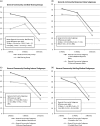Descriptive figures for differences in parenting and infant night-time distress in the first three months of age
- PMID: 27609027
- PMCID: PMC5356193
- DOI: 10.1017/S1463423616000293
Descriptive figures for differences in parenting and infant night-time distress in the first three months of age
Abstract
Aim To provide descriptive figures for infant distress and associated parenting at night in normal London home environments during the first three months of age.
Background: Most western infants develop long night-time sleep periods by four months of age. However, 30% of infants in many countries sleep for short periods and cry out on waking in the night: the most common type of infant sleep behaviour problem. Preventive interventions may help families and improve services. There is evidence that 'limit-setting' parenting, which is common in western cultures, supports the development of settled infant night-time behaviour. However, a recent review has challenged this and argued that this form of parenting risks distressing infants. This study describes limit-setting parenting as practiced in London, compares it with 'infant-cued' parenting and measures the associated infant distress.
Methods: Longitudinal infrared video, diary and questionnaire observations comparing a General-Community (n=101) group and subgroups with a Bed-Sharing (n=19) group on measures of infant and parenting behaviours at night. Findings General-Community parents took longer to detect and respond to infant waking and signalling, and to begin feeding, compared with the highly infant-cued care provided by Bed-Sharing parents. The average latency in General-Community parents' responding to infant night-time waking was 3.5 min, during which infants fuss/cried for around 1 min. Compared with Bed-Sharing parenting, General-Community parenting was associated with increased infant distress of around 30 min/night at two weeks, reducing to 12 min/night by three months of age. However, differences in infant distress between General-Community subgroups adopting limit-setting versus infant-cued parenting were not large or statistically significant at any age. The figures provide descriptive evidence about limit-setting parenting which may counter some doubts about this form of parenting and help parents and professionals to make choices.
Keywords: infant crying; infant sleeping; parenting.
Figures

References
-
- Anders T.F., Halpern L.F. and Hua J. 1992: Sleeping through the night: a developmental perspective. Pediatrics 90, 554–560. - PubMed
-
- Anders T.F. and Keener M. 1985: Developmental course of nighttime sleep-wake patterns in full-term and premature infants during the first year of life. Sleep 8, 173–192. - PubMed
-
- Ball H.L. 2007: Bed-sharing practices of initially breastfed infants in the first 6 months of life. Infant & Child Development 16, 387–401.
-
- Barr R.G., Paterson J., Macmartin L., Lehtonen L. and Young S. 2005: Prolonged and unsoothable crying bouts in infants with and without colic. Journal of Developmental and Behavioral Pediatrics 26, 14–22. - PubMed
Publication types
MeSH terms
Grants and funding
LinkOut - more resources
Full Text Sources
Other Literature Sources
Medical

